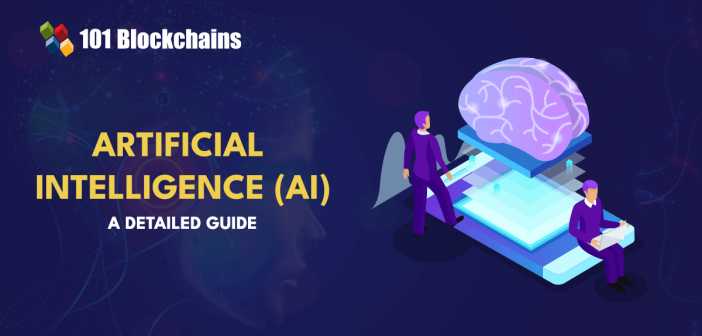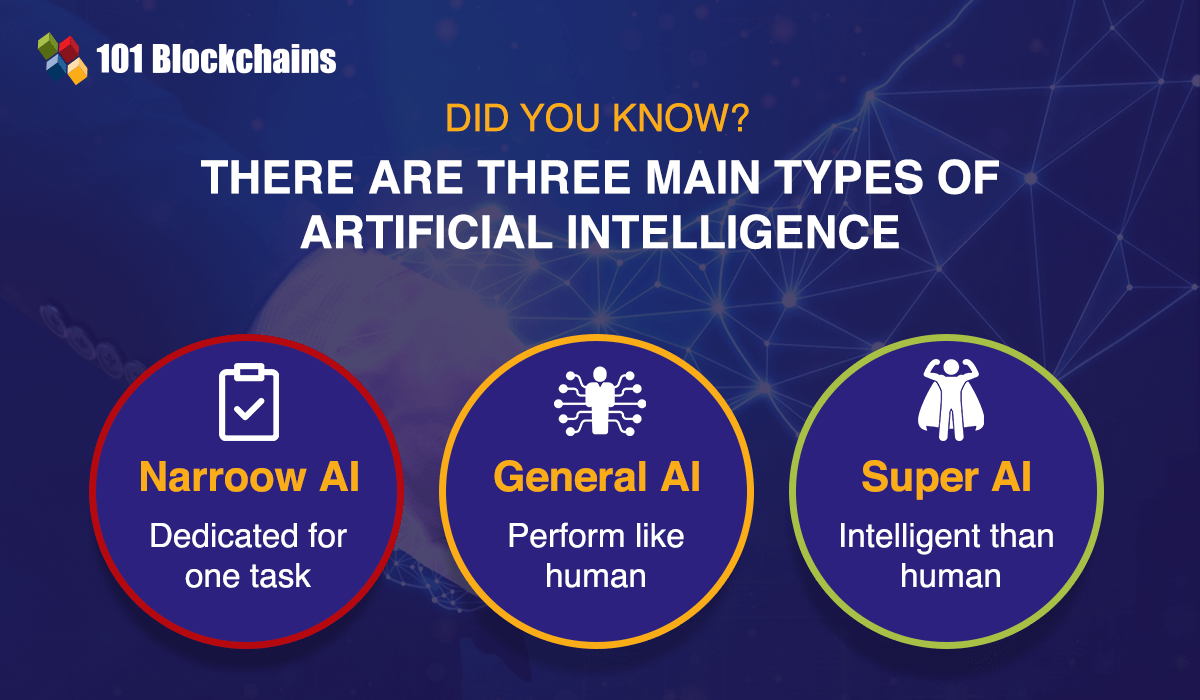Learn how blockchain truly works, master key definitions, and uncover what makes smart contracts so "smart." Dive into the fundamentals, gain valuable insights, and start your blockchain journey today!

- AI & ChatGPT
Georgia Weston
- on July 27, 2023
A Detailed Guide on Artificial Intelligence (AI)
Humans have been thinking of new ways to create intelligent machines for thousands of years. Would you believe that the ancient Greeks had thought of intelligent machines which could work without human intervention? The origins of artificial intelligence explained for the modern generation serve as a glimpse of the potential of innovation in technology. Starting from the 1950s, the rise of AI has been filled with drama, unlike any other technological advancement.
For example, machine learning algorithms have found applications in everyday lives of people across different industries. Artificial intelligence serves multiple use cases, including natural language processing, cancer detection, and predictive analytics. Therefore, the interest in the potential of AI has been growing by huge margins in recent times. The following post serves you with a simple and comprehensive introduction to artificial intelligence, its types, working, and applications.
Definition of AI
The different definitions of artificial intelligence create confusing perceptions regarding the meaning of AI. One of the common answers to “What is artificial intelligence?” points out that AI is the simulation of human intelligence in machines, particularly computer systems. In other words, artificial intelligence refers to the technologies which can help computers perform tasks that require human intelligence.
Some of the advanced tasks addressed by AI include language processing, visual perception, data analysis, video generation, responding to questions, and more. As one of the major trends in modern computing, artificial intelligence poses powerful features. For example, AI could take a text prompt and create a high-quality image or provide customer service through AI-based chatbots.
The descriptions of AI in simple words, also draw attention to one of the earliest definitions of artificial intelligence. Professor John McCarthy introduced AI as a field of study to the world of computer science in 1955. He defined AI as the method for using language to come up with abstractions and concepts, solving problems meant for humans, and enhancing performance of computing systems. The primary objective of artificial intelligence revolves around development of computer programs with the power of problem-solving and achieving goals with the same capabilities as humans.
Take your first step towards learning about artificial intelligence through AI Flashcards
Working of Artificial Intelligence
The formidable growth in hype around AI has led to vendors seeking new ways to showcase the use of AI in their products and services. However, most of the companies adopting AI are actually using a component of AI, such as machine learning. You can find valid responses to “Are artificial intelligence and machine learning the same?” by reflecting on the working of AI.
Artificial intelligence is a broad field of computer science, and machine learning is a subset of AI. From a broader perspective, AI needs a combination of specialized software and hardware for creating and training machine learning algorithms. It is important to note that you can find multiple languages as suitable choices for working with AI. For example, Java, C++, Python, and R have features suited for AI programming.
The working of artificial intelligence systems involves input of massive volumes of labeled training data and analysis of the data for identifying patterns and correlations. Subsequently, AI systems use the patterns to make predictions regarding future states of the system.
The most common artificial intelligence examples in chatbots can prove how AI systems take examples of text as inputs. AI chatbots could use the example text to learn how to interact with users like another person. Similarly, the examples of AI applications in image recognition tools show how AI can review millions of examples for identifying objects in images.
Become a master of generative AI applications and develop expert-level skills in prompt engineering with Prompt Engineer Career Path
Components in AI Programming
The ability of AI to achieve productivity at par with humans for complicated tasks depends on AI programming. The review of artificial intelligence applications would help you uncover how AI programming relies on four cognitive skills. AI programming involves the elements of learning, reasoning, self-correction, and creativity. Each element in AI programming provides a glimpse of the workflow of AI systems.
The first step in AI programming involves learning, which focuses on collection of data. At the same time, the learning stage in AI programming also involves definition of rules for transforming collected data into actionable insights. The rules defined for working of AI systems are known as algorithms. The algorithms provide step-by-step instructions to computing devices for completing specific tasks.
In the second step of AI programming, you would come across reasoning. Reasoning is one of the primary factors underlying artificial intelligence advantages as it enables the selection of right algorithms.
The self-correction element in AI programming is another powerful addition to cognitive skills of AI systems. Self-correction revolves around continuous fine-tuning of AI algorithms for obtaining accurate results.
The final element in AI programming is creativity, which relies on a combination of statistical methods, neural networks, rule-based systems, and AI techniques. Creativity enables AI systems to generate new text, music, images, videos, and ideas from inputs offered by users.
Want to understand the importance of ethics in AI, ethical frameworks, principles, and challenges? Enroll now in Ethics Of Artificial Intelligence (AI) Course
How is Machine Learning Related to AI?
One of the common aspects in discussions around artificial intelligence points to the difference between AI, machine learning, and deep learning. Beginners are likely to ask questions like “Are artificial intelligence and machine learning the same?” during the initial stages. As a matter of fact, companies use AI, machine learning, and deep learning interchangeably in their promotional materials.
However, the terms are different from each other, and AI evolved as an important term in computer science in the 1950s. Artificial intelligence points to the use of technologies for simulating human intelligence in computer systems. The ‘technologies’ used in AI evolve continuously, and the most prominent technologies within the scope of AI are machine learning and deep learning.
The definition of machine learning and deep learning could support an introduction to artificial intelligence explained for beginners. Machine learning helps software applications in improving accuracy for prediction of outcomes without manual intervention or programming. The machine learning algorithms utilize historical data for prediction of new output values. Machine learning has become a powerful approach in AI due to the availability of large data sets for training.
On the other hand, deep learning is a subset of machine learning and revolves around a simulation of the structure of brain. For example, deep learning leverages artificial neural networks, which have served as the foundations for latest AI advancements like ChatGPT.
Excited to learn the fundamentals of AI applications in business? Enroll now in the AI For Business Course
Variants of Artificial Intelligence
Artificial intelligence might seem like an all-encompassing branch of computer science focused on creating intelligent machines. However, a review of artificial intelligence examples would help you uncover the different variants of AI. You can develop a better understanding of AI and its capabilities by learning about the distinct traits of each type of AI.
The three common variants of AI include narrow AI, strong AI, and super AI. Let us find more details about each type of AI and its functionalities.

-
Narrow AI
The first entry among artificial intelligence types refers to narrow AI or weak AI. In the case of narrow AI, the computer systems don’t have full cognitive abilities. On the contrary, the intelligence of the computer system depends on the training or programming for specific tasks. Some of the notable examples of narrow or weak AI refer to image recognition systems, AI chatbots, and speech recognition systems. Popular examples of narrow or weak AI systems are digital voice assistants such as Amazon Alexa and Siri.
-
Strong AI
Strong AI or general AI is more powerful than weak AI in terms of cognitive abilities. The primary highlight of strong AI systems is that they are not restricted to a particular area of expertise. Strong AI systems could perform tasks that are beyond the scope of weak AI systems. The programming of strong AI systems aims at replicating cognitive abilities of human brain. When strong AI systems come across an unfamiliar task, they could utilize fuzzy logic for autonomous solution discovery.
-
Super AI
The concept of super AI or artificial super intelligence (ASI) offers the scope for creating artificial intelligence applications that could outperform human capabilities. For example, the super AI systems could predict future or come up with new scientific methods. As of now, super AI systems might seem like impossible concepts in reality. However, super AI could change the traditional approaches followed for tapping into the potential of AI.
Want to develop the skill in ChatGPT to familiarize yourself with the AI language model? Enroll now in ChatGPT Fundamentals Course
Levels of Intelligence in AI Systems
The outline of the different types of AI provides a clear impression of the capabilities of artificial intelligence. Interestingly, you can also find different categories of AI systems based on their level of intelligence. The common artificial intelligence types include reactive machines, limited memory, theory of mind, and self-awareness. Each type represents a distinct stage of progression in abilities of artificial intelligence with unique value advantages.
First of all, you can notice the reactive machines which use AI to address specific tasks. Reactive machines don’t have any memory and utilize instructions for carrying out certain tasks. For example, the chess program by IBM, Deep Blue, could identify the pieces on chessboard and make relevant predictions.
The next stage of intelligence in AI systems would point to limited memory machines. Such types of AI systems could use historical experiences to define future decisions. The artificial intelligence examples of limited memory machines point at self-driving cars.
Another level of intelligence in AI systems refers to the Theory of Mind or the possibilities for introducing social intelligence. Such types of AI systems could understand human intentions and make predictions regarding behavior. Therefore, the progression of intelligence in AI systems could make them a valuable addition to human teams.
In the final stage of intelligence, AI systems could achieve self-awareness. Self-aware AI systems could understand their existing state and deliver more accurate outputs. As of now, there is no self-aware AI, and it may take some time before the world witnesses such AI systems.
Want to learn how AI and Fintech disrupting finance careers? Join Premium Plan and watch our on demand webinar on How AI And Fintech Are Disrupting Finance Careers!
Examples of AI Applications
The use of AI in different industries has gained prominent traction in the media. The explanation for AI in simple words would highlight the applications of AI and how they deliver value to users. Some of the common examples of AI applications include automation, machine learning, natural language processing, machine vision, and others. Artificial intelligence can help in powering automation, such as in Robotic Process Automation for automation of repetitive tasks. The combination of AI and RPA could help in automation of resource-intensive enterprise tasks.
Machine vision or computer vision is another top addition among artificial intelligence applications with potential for future. The applications of machine vision focus on capturing and analyzing visual information through a camera, signal conversion, and digital signal processing. Another notable example of AI applications points to natural language processing for sentiment analysis, speech recognition, and text translation.
Advantages and Setbacks of AI
The introduction to topics like “What is Artificial Intelligence?” would be incomplete without referring to advantages and limitations of AI. Some of the notable advantages of artificial intelligence include the facility of consistency in results and reduced time consumption for data-intensive tasks. Artificial intelligence could also provide better personalization in customer service alongside saving labor and improving productivity. Most important of all, AI could remove the concerns of downtime by ensuring 24/7 availability of AI-based virtual agents.
On the contrary, the list of artificial intelligence advantages does not provide a viable explanation for the potential of AI. You should also keep an eye on the limitations of AI, such as cost and requirement of technical expertise. At the same time, you may also come across concerns such as bias in training data and ethical issues in AI applications.
Understand the true potential of generative AI and become an expert with the Generative AI skill path
Conclusion
The fundamentals of artificial intelligence explained for beginners show that it is a promising and powerful technology. Artificial intelligence aims at using technologies for creating human intelligence in computer systems. The popular examples of AI applications such as ChatGPT and other tools using AI provide a clear glimpse of the potential of AI.
In the long run, artificial intelligence would be a major technology trend for digital transformation. You can take the initiative to adopt AI in your organization or pursue a career in AI with the help of professional training. Explore the best training courses on AI fundamentals and find out more about the capabilities of AI and machine learning right now.






